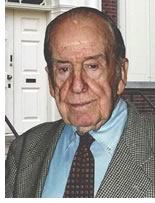

08/2004
Charles E. Peterson, FAIA, Godfather of Historic Preservation, 1906–2004
Charles Emil Peterson, FAIA, Philadelphia, passed away August 17 following a routine day of work. He was six days shy of his 98th birthday. Peterson, described by the Philadephia Inquirer as “an eloquent and indefatigable spokesman for old buildings and their builders,” died of an aneurysm at Pennsylvania Hospital.
 Peterson
is best known in the architecture world as the creator of the Historic
American Buildings Survey, the National Park Service’s nationwide
program to document and preserve historic structures. In keeping with
President Franklin D. Roosevelt’s New Deal policies, Peterson proposed
HABS in 1933 as a 10-week make-work program for 1,200 jobless architects,
drafters, and photographers. The
program, supported from the onset by the AIA, since has documented
35,000 structures with more than 350,000 images and remains one of the
few New Deal initiatives still in existence.
Peterson
is best known in the architecture world as the creator of the Historic
American Buildings Survey, the National Park Service’s nationwide
program to document and preserve historic structures. In keeping with
President Franklin D. Roosevelt’s New Deal policies, Peterson proposed
HABS in 1933 as a 10-week make-work program for 1,200 jobless architects,
drafters, and photographers. The
program, supported from the onset by the AIA, since has documented
35,000 structures with more than 350,000 images and remains one of the
few New Deal initiatives still in existence.
A native of Madison, Minn., who earned his bachelor’s degree in architecture from the University of Minnesota, Peterson actually began working for the National Park Service in 1929, and quickly developed his expertise in historic preservation. In 1931, he helped save the Moore House in Yorktown, Va., the site of the British surrender in the Revolution. His account of the work on the house became the first Historic Structure Report. He subsequently worked on historic properties up and down the East Coast.
During World War II, Peterson served as chief of the Advance Base Engineering Division for Admiral Chester Nimitz’s staff at Pearl Harbor.
He came to Philadelphia in the early 1950s as a National Park Service architect for Independence National Historical Park, located in Philadelphia’s Center City and home of the Liberty Bell and Independence Hall. He was instrumental in the restoration of Carpenters’ and Library Halls. He, along with Edmund Bacon, was deemed responsible for the restoration of Society Hill, where he lived in a rowhouse on Spruce Street from 1954 until his death.
Peterson left the Park Service in 1962 and opened a historic preservation and restoration consulting practice in his home, through which he took on projects “from Hawaii to Morocco.” He served as a volunteer on almost every commission and for every society involved with architectural preservation. He was a founding member of the Association for Preservation Technology in 1968, and served as the group’s president in 1969. In 2000, he wrote The Life and Works of Robert Smith, telling the tale of the architect who designed and built Philadelphia’s St. Peter’s Church and Carpenters’ Hall.
A member of the Philadelphia Historical Commission from 1956–1964,
Peterson served as historian of the Carpenters' Company of the City and
County of Philadelphia and edited an edition of its 1786 rule book. Additionally,
he wrote a column on historic American construction techniques for the
Journal of the Society of Architectural Historians, for 17 years. He also
served as the society’s president.
Peterson was the 1965 recipient of the Louise du Pont Crowninshield Award,
the National Trust for Historic Preservation’s highest honor, and
the 2004 recipient of the Institute of Classical Architecture’s
Arthur Ross Award for History—and received scores of other honors
in between. He was named a Fellow of the Institute in 1962, and received
an AIA Presidential Citation in 1990 and the AIA’s Thomas Jefferson
Award for Public Architecture in 2000. In Peterson’s nomination
for the Jefferson Award, HABS Acting Chief and Principal Architect John
A. Burns, FAIA, wrote, “He is to historic architects what Richard
Morris Hunt is to the profession as a whole: a primary force in the evolution
of architectural practice.”
HABS, The Athenaeum of Philadelphia, and the AIA have for the past 19 years honored Peterson annually by awarding the Charles E. Peterson Prize, which recognizes the best set of measured drawings prepared to HABS standards and donated to HABS by students. To date, more than 2,000 architecture students from 66 colleges and universities have taken part.
Although he never retired, Peterson had been confined to his Spruce Street home and office for the past two years. His family reportedly had been planning a party for his 98th birthday on August 23. A memorial service to honor this “eloquent and indefatigable spokesman for old buildings” will be held at 1 p.m. September 18 at Philadelphia’s Christ Church.
Copyright 2004 The American Institute of Architects.
All rights reserved. Home Page ![]()
![]()
 |
||
|
|
||